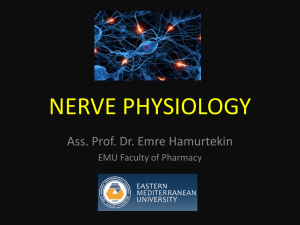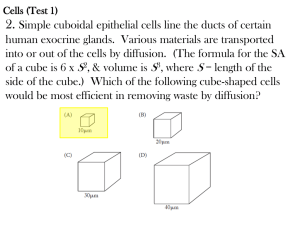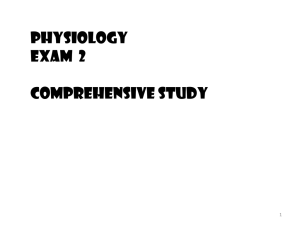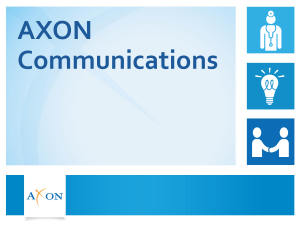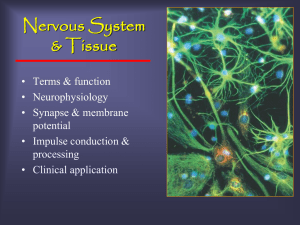CH2
advertisement
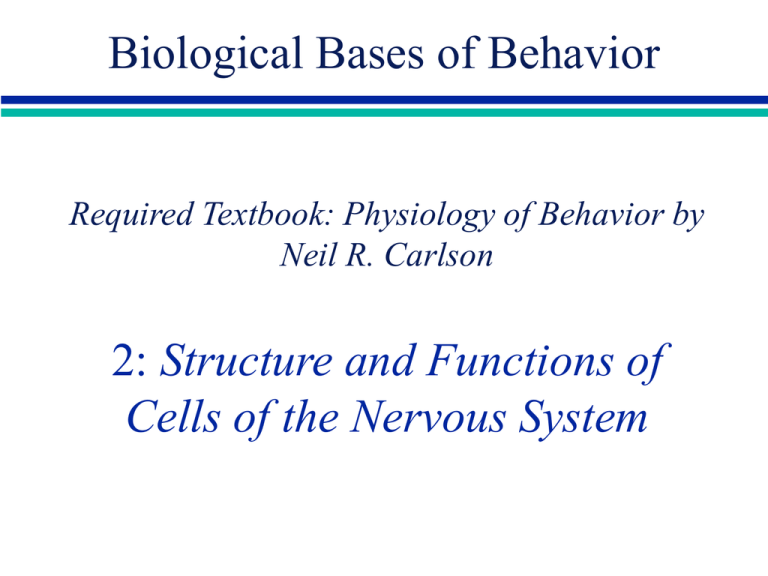
Biological Bases of Behavior Required Textbook: Physiology of Behavior by Neil R. Carlson 2: Structure and Functions of Cells of the Nervous System Neuron Structure multipolar 2.2 Neuron Classification Schemes Neurons can be classified according to Number of axon processes: Unipolar: one stalk that splits into two branches Bipolar: one axon, one dendritic tree Multipolar: one axon, many dendritic branches Function Sensory neurons carry messages toward brain Motor neurons carry messages to muscles Interneurons connect cells Neurotransmitter (NT) used by neuron Effects of NT (excitatory vs. inhibitory) 100 billion neurons 2.3 Bipolar(a) - Unipolar(b) Neurons 2.4 Electrochemical Conduction Nerve cells are specialized for communication/information processing (neurons conduct ELECTROCHEMICAL signals) Dendrites receive chemical message from adjoining cells Chemical messengers activate receptors on the dendritic membrane Receptor activation opens ion channels, which can alter membrane potential Action potential can result, and is propagated down the membrane Action potential causes release of transmitter from axon terminals 2.5 Neuron Internal Structure 2.6 CNS Support Cells Neuroglia (“glue”) provide physical support, control nutrient flow, and are involved in phagocytosis Astrocytes: Provide physical support, remove debris (phagocytosis), and transport nutrients to neurons Microglia: Involved in phagocytosis and brain immune function Oligodendrocyte: Provide physical support and form the myelin sheath around axons in the brain Schwann Cells form myelin for PNS axons 2.7 Astrocytes & Capillary in Brain 2.8 Measuring the Resting Membrane Potential of a Neuron Giant axon from a squid is placed in seawater in a recording chamber 0.5mm in diameter, hundreds of times larger than mammalian axon Voltmeter -70 mV Microelectrode Glass microelectrode is inserted into axon Tiny tip, ~ micrometer Voltage measures -70 mV inside with respect to outside Axon Chamber 2.9 Resting Membrane Potential Resting membrane potential (RMP) is the difference in voltage between the inside and outside of the axon membrane NA+ ions are in high concentration outside the cell, while K+ ions are in high concentration inside the cell At rest, sodium-potassium transporters (pumps) push three NA+ ions out for every two K+ ions they push in, causing the exterior of the nerve cell membrane to be slightly positive relative to the inside of the axon 2.10 Relative Ion Concentrations Across the Axon Membrane 2.11 The Action Potential AP is a stereotyped change in membrane potential If RMP moves past threshold, membrane potential quickly moves to +40 mV and then returns to resting Ionic basis of the AP: NA+ in: upswing of spike Diffusion, electrostatic pressure K+ out: downswing of spike 2.12 Ion Channels and the AP 2.13 Properties of the Action Potential The action potential: Is an “all or none” event: RMP either passes threshold or doesn’t Is propagated down the axon membrane Notion of successive patches of membrane Has a fixed amplitude: AP’s don’t change in height to signal information Has a conduction velocity (meters/sec) Has a refractory period in which stimulation will not produce an AP (limits the firing rate) 2.14 Local Potentials Local disturbances of membrane potential are carried along the membrane: Local potentials degrade with time and distance Local potentials can summate to produce an AP 2.15 Saltatory Conduction AP’s are propagated down the axon AP depolarizes each successive patch of membrane in nonmyelinated axons (thereby slowing conduction speed) In myelinated axons, the AP jumps from node to node: AP depolarizes membrane at each node Saltatory conduction speeds up conduction velocity Conduction velocity is proportional to axon diameter Myelination allows smaller diameter axons to conduct signals quickly 2.16 More axons can be placed in a given volume of brain Synapses The “synapse” is the physical gap between pre- and post-synaptic membranes (~20-30 nMeters) Presynaptic membrane is typically an axon The axon terminal contains Mitochondria that provide energy for axon functions Vesicles (round objects) that contain neurotransmitter Cisternae that are a part of the Golgi apparatus: recycle vesicles Postsynaptic membrane can be A dendrite (axodendritic synapse) A cell body (axosomatic synapse) Another axon (axoaxonic synapse) Postsynaptic density (thickening) lies under the axon terminal and contains receptors for transmitters 100 trillion synapses 2.17 Overview of the Synapse ------------ Cisterna 2.18 Neurotransmitter Release Vesicles lie “docked” near the presynaptic membrane The arrival of an action potential at the axon terminal opens voltage-dependent CA++ channels CA++ ions flow into the axon CA++ ions change the structure of the proteins that bind the vesicles to the presynaptic membrane A fusion pore is opened, which results in the merging of the vesicular and presynaptic membranes The vesicles release their contents into the synapse Released transmitter then diffuses across cleft to interact with postsynaptic membrane receptors 2.19 Overview: Transmitter Release 2.20 Postsynaptic Receptors Molecules of neurotransmitter (NT) bind to receptors located on the postsynaptic membrane Receptor activation opens postsynaptic ion channels Ions flow through the membrane, producing either depolarization or hyperpolarization The resulting postsynaptic potential (PSP) depends on which ion channel is opened Postsynaptic receptors alter ion channels Directly (ionotropic receptors) Indirectly, using second messenger systems that require energy (metabotropic receptors) 2.21 Metabotropic Receptors 2.22 Postsynaptic Potentials PSPs are either excitatory (EPSP) or inhibitory (IPSP) Opening NA+ ion channels results in an EPSP Opening K+ ion channels results in an IPSP PSPs are conducted down the neuron membrane Neural integration involves the algebraic summation of PSPs A predominance of EPSPs at the axon will result in an action potential If the summated PSPs do not drive the axon membrane past threshold, no action potential will occur 2.23 Termination of Postsynaptic Potentials The binding of NT to a postsynaptic receptor results in a PSP Termination of PSPs is accomplished via Reuptake: the NT molecule is transported back into the cytoplasm of the presynaptic membrane The NT molecule can be reused later --- inserted into new vesicles produced by cisternae (membrane from pinocytosis), one minute for the entire recycling Enzymatic deactivation: an enzyme destroys the NT 2.24 molecule Other Types of Chemical Communication Neuromodulators, mostly peptides Hormones Released by neurons, affect many neurons, e.g., opiates produced by brain (mimiced by heroin) Released by endocrine glands, affect cells by stimulating metabotropic receptor or to by entering cell nucleus, e.g., steroid (from cholesterol) altering protein production Other types of neurotransmitters Autoreceptors: metabotropic through G proteins and second messengers to reduce synthesis or release of NT Other types of synapses: axoaxonic (presynaptic inhibition or facilitation), dendrodendritic (gap junction) 2.25



